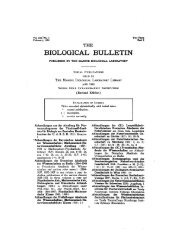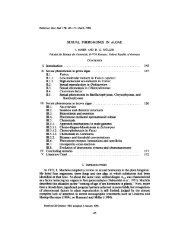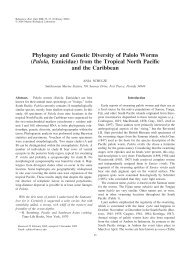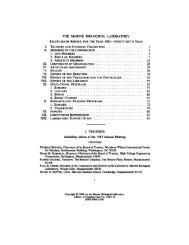NUTRITIONAL STUDIES ON THE AMOEBO-FLAGELLATE ...
NUTRITIONAL STUDIES ON THE AMOEBO-FLAGELLATE ...
NUTRITIONAL STUDIES ON THE AMOEBO-FLAGELLATE ...
You also want an ePaper? Increase the reach of your titles
YUMPU automatically turns print PDFs into web optimized ePapers that Google loves.
NUTRITI<strong>ON</strong> OF TETRAMITUS ROSTRATUS<br />
273<br />
Selection<br />
of a medium<br />
EXPERIMENTS AND RESULTS<br />
Experiments with most empirical formulae and those media already known to<br />
support axenic growth of the free-living Protozoa described above, proved un<br />
successful for Tetramitus. Axenic growth of Tetramitus could be obtained, how<br />
ever, when washed autoclaved Bacillus cereus was added to a medium consisting<br />
of 0.5% yeast extract, 0.5% peptone and 1.0% Wilson liver concentrate (N.F.). In<br />
the yeast-peptone-liver medium (designated as YPL) sterile young amoebae were<br />
@ 2—3times larger than normal (60 in diameter) and usually appeared opaque and<br />
immobile, but they became progressively more active as the cultures became older.<br />
Through varying the pH from 5.5 to 7.9 it was found that better growth could be ob<br />
DAYS<br />
FIGURE 1. Comparison of growth of populations of T. rostratus with living vs. autoclaved<br />
B. cereus in 5 ml. of YPL medium at 300 C. Inoculum- 870/ml. •¿: Growth with living<br />
bacteria; o: Growth with dead bacteria. Note: Each point represents a separate tube.<br />
tamed near neutrality (6.8—7.3). Altering the temperature from 20°C. to 35°C.<br />
demonstrated that optimum growth (150 per mm.8) could be reached in approxi<br />
mately 12 days at 30°C.<br />
A distinct lag phase was observed when the amoebae were grown with dead<br />
B. cereus (Fig. 1), which was considerably longer than that obtained with living<br />
bacteria. This would seem to indicate that although this medium is capable of<br />
supporting growth and reproduction of the amoebae, it is far from perfect and is<br />
incapable of supplying all the factors derived from cultures containing living bac<br />
teria. Preliminary experiments to shorten this lag with Selas-filtered, Precon<br />
ditioned bacterial cultures have not proved promising.<br />
Attempts were made to substitute other autoclaved bacteria for B. cereus in YPL<br />
broth. Considerable growth of the amoebae could be obtained with killed Es<br />
cherichia coli, Neisseria catarrhalis, Sarcina lutea and Bacillus subtilis by culturing










